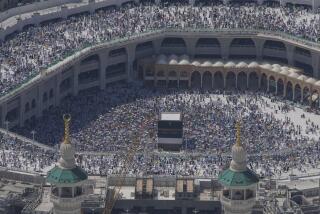Sacred Journey to Mecca Unites World’s Muslims : Islam: An estimated 2 million will participate in the hajj, which culminates May 10 with a feast marking the sacrifice of Abraham.
- Share via
Early next week, with the sighting of the first crescent moon, a month of pilgrimage will begin for Muslims around the world. An estimated 2 million people will travel to the Saudi Arabian city of Mecca to participate in the three-day ritual known in Arabic as the hajj.
On May 8, boys and men will trade their usual clothing for two unstitched sheets of white cloth. Clad in these simple garments, which eliminate any distinctions between rich and poor, the pilgrims will circle the ancient, cube-shaped building known as the Ka’bah, praying together.
Then comes a day of reflection, on a barren plain outside Mecca, and a ritual casting of stones. The pilgrimage culminates with a great feast May 10, celebrated by Muslims around the world with the ritual slaughter of animals to commemorate the sacrifice of Abraham.
To outsiders, such practices seem strange, even threatening, because Islam is often regarded as a militant and mysterious faith. Yet the hajj expresses a human yearning common to all religions: a search for the inner peace that comes from a close relationship with God.
Indeed, the name Islam derives from the Arabic word salaam , which means peace. And Muslim, literally translated, is one who “seeks the peace of God,” or who has “reconciled or surrendered” to God.
The hajj is a sacred journey required at least once in the life of every Muslim capable of making the trip. Those who journey to Mecca often return with a new clarity about their religion and consider the experience pivotal in their religious lives.
Though only Muslims are allowed to have this experience, its rituals are not secret. So just by reading about it, outsiders can make an intellectual pilgrimage to Mecca, joining the Muslim world in a shared journey to the center of Islamic belief.
Some of the most dramatic images of the pilgrimage to Mecca occur May 8, at the official beginning of the hajj, when pilgrims circle the black-draped Ka’bah, which Muslims believe was built by the Prophet Abraham and his first-born son. To Muslims it represents God’s concern for humankind, just as the Ark of the Covenant did for the ancient Jews and the image of the crucified Jesus does for Christians.
According to the Koran, father Abraham and son Ishmael built the Ka’bah and at God’s command, Abraham made it a place of pilgrimage. It is this story that is re-enacted during the hajj.
After circling the Ka’bah, pilgrims proceed between the same two hills as Hagar did in a ritual called “the running,” to reinforce the idea that God is merciful and compassionate--the main attributes of God for Muslims.
The second day of the pilgrimage is known as the “day of standing,” when Muslims gather on a barren plain outside of Mecca from noon until after sunset to examine their consciences. The experience is meant to be a foretaste of the Day of Judgment, when Muslims believe that an individual’s deeds and misdeeds will be revealed.
The pilgrimage culminates May 10, with Eid al-Adha, or the “day of feasting.” which Pilgrims begin by gathering pebbles from the ground and casting them at three pillars, commemorating Abraham’s rejection of Satan’s temptations to ignore God’s command to sacrifice his son.
Just as Abraham was finally permitted to sacrifice a ram instead of his child, the hajj ends with the ritual sacrifice of animals and a great feast and celebration.
For some Muslims, the hajj is the culmination of a lifetime of religious observance; for others, it initiates them into a religion they suddenly realize they barely knew.
For Christians and Jews, understanding the hajj serves as a reminder of the essential message that all three religions strive to convey about the God of Abraham: That there is only one.
More to Read
Sign up for Essential California
The most important California stories and recommendations in your inbox every morning.
You may occasionally receive promotional content from the Los Angeles Times.













